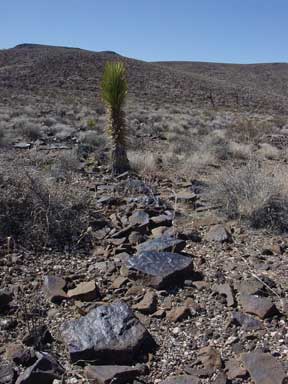|
News Notes
Geochemistry
Desert varnish baked in Mojave
 For decades, desert varnish — the black, shiny coating found on rocks in deserts from the Gobi to the Mojave — has puzzled scientists trying to unravel the mystery of how it forms. Most proposed explanations have focused on the possibility that microbes play an active role in producing the coating. In a new study, however, researchers make the case that nonbiological processes actually produce the varnish, and that microbes are little more than passive bystanders. The rock coatings also may hold clues about past life on Earth — and maybe even on Mars.
For decades, desert varnish — the black, shiny coating found on rocks in deserts from the Gobi to the Mojave — has puzzled scientists trying to unravel the mystery of how it forms. Most proposed explanations have focused on the possibility that microbes play an active role in producing the coating. In a new study, however, researchers make the case that nonbiological processes actually produce the varnish, and that microbes are little more than passive bystanders. The rock coatings also may hold clues about past life on Earth — and maybe even on Mars.
Desert varnish gives rocks a black, shiny look in dry environments, such as Death Valley National Park in California, shown here. A new study suggests the coating forms from nonbiological processes, but other scientists say that microbes play a role. Photograph is by Randall Perry.
Scientists know that desert varnish forms slowly, over the course of thousands of years, but they have debated its origin. One prevailing idea among scientists has been that bacteria play a role in desert varnish by producing manganese oxide, the component that gives the coating its dark color. The idea gained credence when scientists found amino acids and DNA in varnish coatings. Randall Perry, an organic geochemist at Imperial College in London, says that he, too, always expected a biological mechanism, yet such explanations “never really made sense since we and others never saw many bacteria on the surface of the varnished rock.”
Then, “while sitting at a café in Nice,” France, with a scientist who was working on silica organic chemistry, Perry says, it occurred to him that perhaps silica was involved in the formation of desert varnish. “It was like a light going off after 20-some years of wondering how the stuff formed,” he says.
Subsequent analyses using microscopy and spectroscopy techniques suggested that silicon is the primary element in desert varnish, as Perry and colleagues reported in the July issue of Geology. The team now thinks that varnish coatings form through a nonbiological process when silica dissolves out from minerals on rock surfaces, then gels, bakes and hardens.
The researchers say that the amino acids and DNA previously found in desert varnish — along with other materials, such as pollen, soil components and pollutants — come from the surrounding environment. According to Perry, winds deposit these materials, which become entombed in the varnish as it forms. As such, he says, desert varnish provides an “environmental diary” of the past, much like insects preserved in amber.
Furthermore, Perry says that desert varnish “is a special case of silica glazes that appear to be widespread on Earth,” meaning that other silica-based coatings — such as those in caves, hydrothermal deposits and even on Mars — could also harbor evidence of past environments.
Not all scientists, however, are sold on the silica explanation. Ron Dorn, a geographer at Arizona State University in Tempe, says the silica model falls short in explaining a number of varnish characteristics, including the higher concentration of manganese in varnish compared to that in the underlying rock, dust, or nearby soil. In addition, Dorn — who prefers a “polygenetic” model that combines both biological and nonbiological processes — questions the usefulness of desert varnish as a window into past environments. “It is just very, very unusual to see complete microfossils inside varnish,” he says.
Jennifer Yauck

 Subscribe
Subscribe

